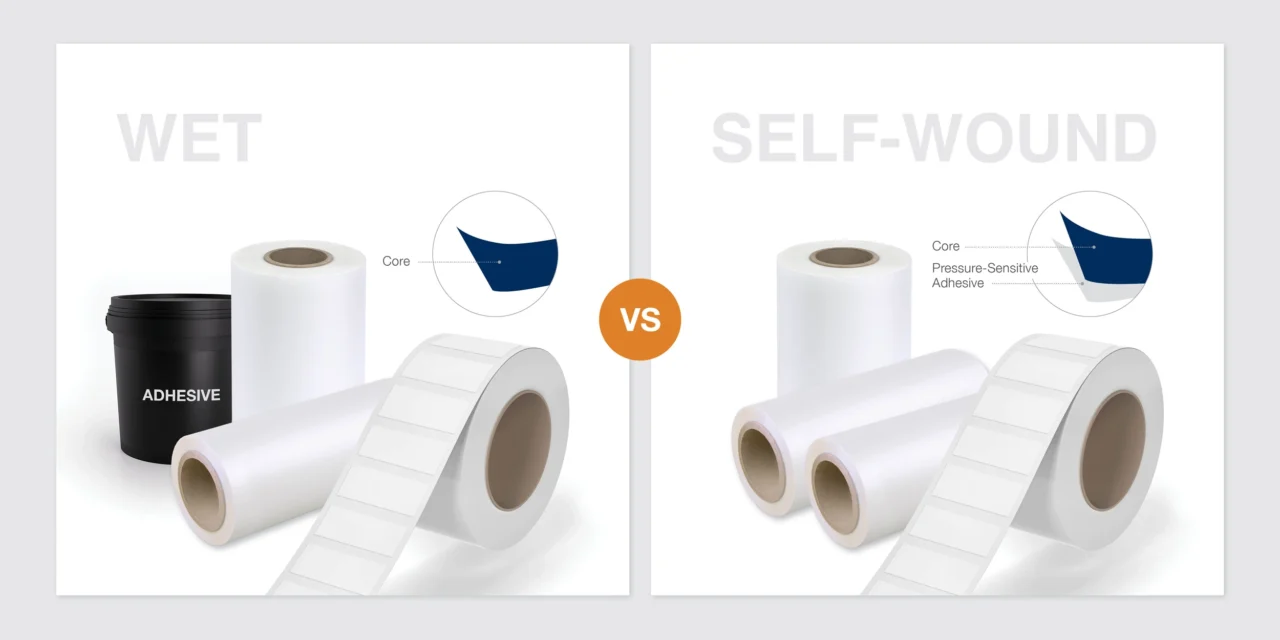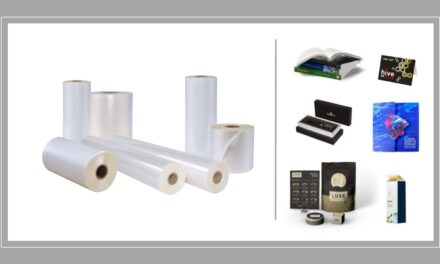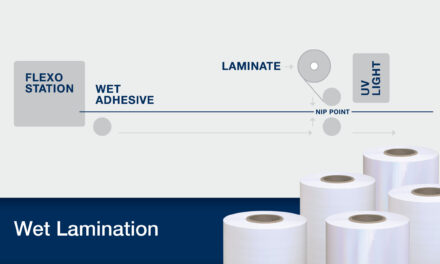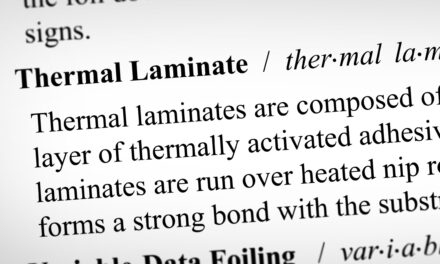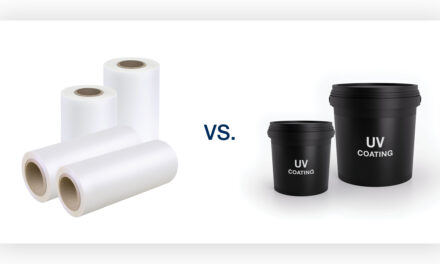LAMINATION FOR PRIME LABELS
Like many printers throughout the print and packaging industry, most prime label converters have found that lamination is the best way to protect graphics from all types of damage, be it scuffing, moisture, or grease and oils. Unlike coatings and other forms of protection, lamination gives labels a durable top layer that can endure packing, shipping, and repeated handling on store shelves. Lamination may be recognized as a consistently high-quality finishing solution for the label industry, but is the average prime label converter aware that there are several types of lamination, each with its own benefits and drawbacks?
In this article, we will take a brief look at two of the leading lamination solutions for the prime label industry: self-wound lamination and wet lamination. Self-wound lamination has long been the more popular option, but every year, more prime label converters are switching over to wet lamination. However, due to self-wound lamination’s popularity, many label printers still do not know that wet lamination is even an option.
WHAT IS THE DIFFERENCE BETWEEN WET LAMINATION AND SELF-WOUND LAMINATION?
Self-wound laminates include a pressure-sensitive adhesive layer on one side of the web. These laminates are applied directly to face stock without any extra adhesive, needing only pressure to form a strong bond with the substrate. On the other hand, wet lamination, as its name implies, involves the use of a separate liquid adhesive instead of an included pressure-sensitive layer.
In the wet lamination process, wet adhesive is poured into the final deck on a flexographic press and applied to the face stock via an application roller. The film loaded onto the press’s laminate mandrel does not include any adhesive layer, which is why it is frequently referred to as “unsupported film”. Instead, the unsupported film is applied to the adhesive-coated face stock and then immediately cured through the same UV/LED technology used to cure spot varnish.
Both self-wound and wet lamination are quick, simple, and efficient ways to ensure ink cannot be rubbed off a label or otherwise damaged, and the quality of the final product in either method depends on the skill of the press operator and the quality of the materials used. Still, they differ in many ways that may make one process or the other more suitable for a given prime label converter.
WET LAMINATION VS SELF-WOUND LAMINATION
When margins are as thin as those in the prime label space, printers must closely examine every aspect of their process to ensure they are making the most of each investment and using every second on the production floor wisely. There are four key areas where self-wound lamination and wet lamination differ regarding their impact on a prime label converter’s bottom line.
1. Cost of Materials
Prime label converters who utilize self-wound lamination trade affordability for convenience. Because self-wound laminates are more processed than unsupported alternatives, they usually cost more for the printer. For many prime label converters, this tradeoff is acknowledged and embraced because the margin loss may be as little as a few cents per label. However, the more labels a business produces, the more impactful a few cents per label becomes. Prime label converters who use self-wound laminates simply because it is the default choice in the industry may be sacrificing significant margins on each job without even realizing it.
Unsupported films, however, have a simpler construction and are less processed, which means printers are not paying a premium for the adhesive to be pre-applied in manufacturing. In the same way that it is almost always less expensive to buy the ingredients for a cake and bake it at home yourself than it is to get the same cake at a bakery, purchasing unsupported film and a compatible wet adhesive separately and then combining them on a flexographic press or a digital finishing press is typically more cost efficient than purchasing the self-wound equivalent.
If minimizing material costs is a top priority for a prime label converting business, it is difficult to choose a more economical option than wet lamination. However, some operations may accept higher material costs if it means other processes do not have to change and their employees do not need to be retrained to use a different method. This is an opportunity cost that each business owner must weigh based on intimate knowledge of their own workflow, capabilities, and labor force.
2. Ease of Use
While self-wound laminates are generally more expensive than unsupported alternatives, it is certainly difficult to compete with their convenience and ease of use. Self-wound laminates are simply loaded onto the flexographic press’s film mandrel and are instantly ready for application. They require no cleanup and very little in the way of operator training. It is this simplicity and straightforwardness that justifies their price point for many printers in the prime label industry.
In comparison, wet lamination can seem intimidating or challenging as there are more materials and more steps in the process. Printers who use wet lamination must know where to source not just the unsupported film but also adhesives that are compatible with both their face stock and film. The adhesive must be poured into a deck on the press and then cleaned out much like an ink (although printers can always choose to simply cover the adhesive deck to prevent it from drying out and change out adhesive decks as needed; for more information on this aspect of the process, read the “Adhesive Storage” section in Troubleshooting Tips for Wet Lamination.) Finally, the flexographic press should have UV or LED curing technology to instantly cure the adhesive.
Despite the relative complexity of wet lamination, Nobelus has worked with many prime label converters who have successfully navigated the transition away from self-wound laminates and now consider wet lamination a seamless process. Additionally, many converters who use wet lamination find that quality issues commonly seen with self-wound laminates, such as adhesive voids and fisheyes, do not appear in their labels. Our in-house solutions experts have partnered with adhesive formulation experts to validate which wet adhesives are most compatible with our films to ensure our customers know exactly where they can source all the materials they need.
Converters who are not equipped to handle a significant change in their processes or feel their team is not ready to learn a new method may not be able to trade in the convenience of self-wound lamination for the benefits of wet lamination. However, operations that successfully move to wet lamination will find the process becomes much simpler once they overcome the initial learning curve.
3. Diversity of Finishes
Historically, self-wound laminates have come in only two finishes: gloss and matte. This limited selection is due to the fact that the laminate includes a pressure-sensitive adhesive layer. When a self-wound laminate is wound up into a roll, the sticky adhesive bottom layer presses against the face of the film. Since this adhesive is activated through pressure, winding it into a roll can create issues with sticking when it is time for the roll to smoothly unwind on the press.
To counteract the effects of the adhesive, self-wound laminates must include a non-stick coating on the surface of the film so the roll will unwind properly. Many finishes common in the printing industry would either have their value-add effect negated by a non-stick coating or else be unable to receive the coating altogether. For this reason, prime label converters who use self-wound laminates are highly limited in what finishes and effects they can offer brands and consumers. For certain markets, gloss and matte may be sufficient, but as store shelves get more crowded and more brands vie for the attention of consumers, many printers are looking for ways to stand out.
For these converters, wet lamination can enable them to offer more finishes than ever before. Because unsupported films do not need protection from a pressure-sensitive layer, they do not require any sort of non-stick coating and can therefore be treated, embossed, and otherwise altered as needed to create unique finishes and effects. For instance, Karess® Film, an unsupported film from Nobelus with a luxurious soft-touch feel, could not be recreated on a self-wound laminate because the non-stick coating would dull the velvety haptic effect. Other finishes in the Nobelus Prime Label Unsupported Film portfolio include a rugged rough-touch finish and a durable scratch-proof film.
Offering a wider selection of specialty finishes and effects can help label converters position their business with luxury brands, niche markets, and new brands who are looking for ways to establish a customer base by standing out. It can also enable label producers to match a brand’s other packaging formats for more consistent marketing, such as putting a soft-touch label on a jar that will be sold in a folding carton with its own soft-touch finish.
4. Market Flexibility
Prime label converters who have an interest in expanding into other markets will find that the flexibility of wet lamination far exceeds that of self-wound laminates. While self-wound options are used specifically for prime labels, wet lamination and the unsupported films used in the process provide a perfect avenue for growth in markets such as flexible packaging.
Solventless and solvent-based lamination are both forms of wet lamination and are extremely popular in the flexible packaging space. Gaining familiarity with and even mastery of wet adhesives can equip prime label converters to experiment with flexible packaging and take their initial steps into an exciting, fast-growing market.
COMPREHENSIVE SUPPORT FOR PRIME LABEL CONVERTERS
If you are a prime label converter who is interested in learning more about wet lamination or feels ready for a trial run, reach out to the Nobelus client support team through phone or email. We offer a comprehensive range of finishes for labels in our unsupported film portfolio and would love to come alongside your team to provide education, sample rolls, guidance on product trialing, quality control, and many more services to help get your wet lamination workflow up and running. Our in-house solutions experts have decades of experience in label production, and our customer care representatives are always ready to answer your call.

